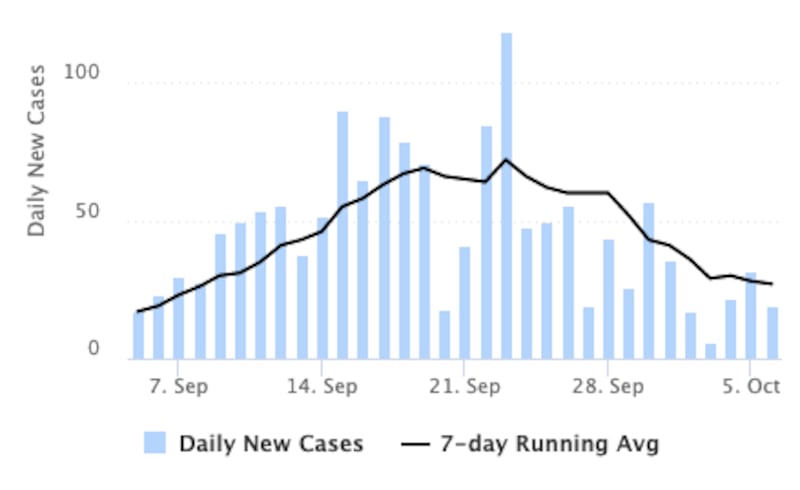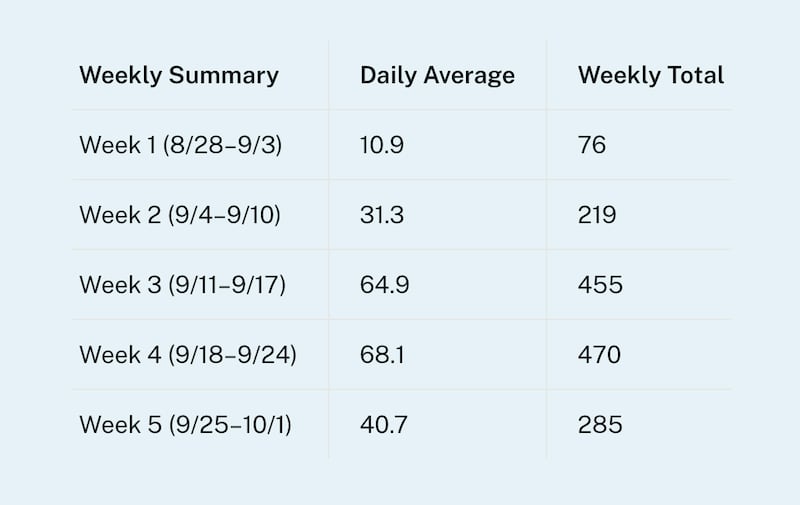PROVO — Brigham Young University’s coronavirus outbreak appears to be easing.
BYU’s seven-day rolling average of new COVID-19 cases is now 27 per day, down from 68 a day two weeks ago, when students who returned to Utah County helped make it the state’s hotspot for coronavirus cases.

“The trends we’re seeing at BYU are encouraging. The number of active cases and the 7-day rolling averages of new cases and active cases within our campus community have decreased,” Branden Wilson, managing director of BYU Risk Management and Safety, said in a statement. “This decline in cases is real, and the decline is not a result of a decrease in testing or a decrease in receiving reported test results.”
There have been no reports of COVID-19-related deaths at BYU. Neither the university nor the Utah County Health Department has reported the number of hospitalizations, though the number is low compared to the national average.
Since Sept. 1, Utah County has had a total of 11,170 cases, with a spike that at one point drew comparisons to the worst spikes in New York City. The number of hospitalizations remained chiefly steady and the number of COVID-19-related deaths during that time, 17, corresponds to a death rate of less than two-tenths of 1%.
Wilson credited students for the drop in cases at BYU. He said they responded well to a joint letter from BYU President Kevin Worthen and Utah Valley University President Astrid Tuminez asking students to change their behavior.
“The recent efforts of students, faculty and staff have been effective in slowing the spread of COVID-19 within our campus community,” Wilson said. “We are grateful to each of you for your positive response. It is vital that we maintain these efforts and behaviors to prevent another spike and to continue the decrease in active cases.”
Cases in Provo and at BYU began to surge soon after school began in late August and spiked after weeks of dance parties. BYU has now had 1,598 positive cases, totaling 3.7% of its campus population of 43,000 faculty, staff and students.
The University of Utah has had 593 cases, Utah State University has had 539 and UVU has seen 337.

However, 1,440 of BYU’s cases have completed their quarantine. BYU now has just 158 active COVID-19 cases, or 0.37% of the campus community.
The school has moved some students who test positive into quarantine housing set up in Heritage Halls apartments and at its Aspen Grove Family Camp. Other students have quarantined in place.
Provo City Mayor Michelle Kaufusi vetoed a citywide mask mandate on Aug. 26, but the City Council overrode her veto the following day. On Sept. 22, with cases spiking at BYU and throughout the county, Utah officials moved Provo and Orem to the orange, or moderate, restriction level and Worthen and Tuminez sent their letter.
The following day, the Utah County Commission issued a mask mandate.
Worthen and Tuminez warned that they might be forced to move the entire BYU and UVU semesters to online instruction for the rest of the semester if students couldn’t help halt the spread of the virus.
Some professors independently moved to online on a temporary basis. Both schools are using hybrid models of in-class and online instruction. In some classes, students take turns attending physically and virtually.
Just seven weeks of in-class instruction remain for most students. BYU will move all classes online after the Thanksgiving break, and UVU will move nearly all of its classes to livestreaming or online.
BYU previously disciplined at least 15 students who refused to follow the university’s COVID-19 safety requirements. Students, faculty and staff are required to log in each day to the Healthy Together app, complete a checkup questionnaire and obtain a daily campus passport. Professors are authorized to verify that a student has the passport, but multiple students have said that does not happen regularly.
BYU also is conducting randomized testing on students and employees.


 alt=Tad Walch
alt=Tad Walch